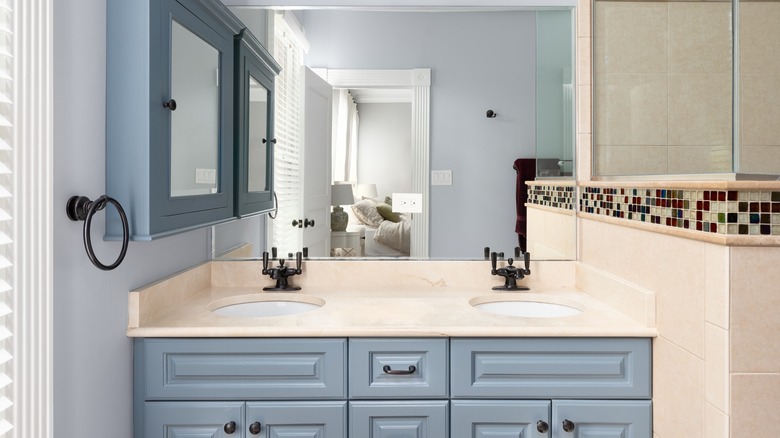Why A Drawer Is The Perfect Alternative To A Medicine Cabinet
We may receive a commission on purchases made from links.
As fads and trends in home designs change, you may notice that certain staples are becoming less widely used. For example, medicine cabinets were introduced as a popular addition to bathrooms in the 19th century, and not only intimated status but provided a necessary place to store medications and toiletries. As they became a common part of most homes, their styles and designs were upgraded to suit more modern dwellings, with the recessed cabinets being fairly standard in bathrooms and powder rooms. However, it seems that this once-popular bathroom trend is now disappearing from some floor plans, and people have begun wondering what can replace it. After all, having a designated area to keep pills, medications, salves, and first aid items is important for many. Rather than shoving everything in a box or cluttering surfaces with bottles, why not turn a drawer into the ultimate storage solution and one-stop shop for your medicine collection?
Even if medicine cabinets are fading from home designs, you have options for your toiletries and medications. A drawer makes for a perfect alternative to a medicine cabinet because it's an easy transition to make, and it keeps your necessities accessible yet out of sight. The main thing you want to focus on when using a drawer instead of the shelves usually built into a medicine cabinet is investing in organizers. A medicine and toiletry drawer can easily turn into a junk pile if your items aren't properly stored.
How to organize a medicine and toiletry drawer
When it comes to setting up your medicine drawer, it's worth purchasing multiple organizers or a tray that separates your items. Options like the Freshmage Drawer Organizer Set allow you to group certain pills, salves, and other necessities so they are easy to find. Depending on how deep your drawer is, you could use cup-style organizers, too. Another option would be to use supplies to create a horizontal display like the Dollar Tree spice rack hack, which allows you to stack your pill bottles for a more efficient system.
Consider separating everything by category to make it easier to access what you need. Things like Neosporin and antihistamine creams could all be kept together, while another tray could be filled with Band-Aids, butterfly stitches, and so on. The same goes for medicines like Tylenol, which can be kept in their bottles or in labeled packets, making them easier to stack. Larger items that would usually go on the bottom of your medicine cabinet may need to go in your cupboard or extra storage you can hang on the back of your door.
Pre-organizing steps
Before setting up your medicine drawer, it's important to go through your toiletries, medications, and other supplies. It's normal to just move all of your items into your new storage drawer, but weeding out expired or unusable supplies helps to make more room for those you need. First, sort through everything and determine what can be tossed out or donated. Get rid of expired makeup, lotions, old soaps, and anything else you don't use as much, as well as expired medications and even old Band-Aids that might not have as much adhesive. This is an easy way to declutter and organize cabinet drawers from the outset. Next, make sure to label anything that is in a nondescript jar. Get creative by taking certain items like Band-Aids out of their boxes to make more room in your drawer.
As you're organizing your medicine drawer, it's also important to keep the space clean. Many of your medications may be in bottles or sealed storage, but dust and grime can collect around them. When you're swapping out your items, give everything a good dust as particles can collect in your drawers every time you open them. All of this will help make everything more organized and tidy. Try to do this at least once a year, including the session where you replace old medicines.


